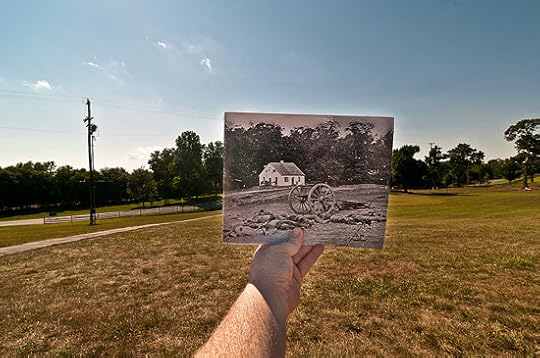Sheron Long's Blog, page 39
September 26, 2013
What’s Napoleon Doing in a Japanese Rice Paddy?
Across the summer of 2009, this image of Napoleon emerged in a rice field in Inakadate—
a slow reveal for an emperor used to making a grand entrance!
(Image by Captain76)
He’s Growing from Creative Inspiration and Some Seeds!
In fact, Napoleon grew from several different kinds of seeds that sprouted in different colors. They became the “paint” on this giant canvas depicting the French emperor.
Origins of Tanbo Art
Known as tanbo (rice paddy) art, or tambo art, the idea originated in 1993 with Japanese villagers in Inakadate. They had a creative inspiration—grow a huge image in the rice paddy behind town hall.
The fascinating result was a depiction of Mount Iwaki. Across the next 20 years, the idea spread to other Japanese villages, and images became more complex revealing other landscapes and larger-than-life figures of the Mona Lisa,...






September 25, 2013
Secrets to Life #102: Stand Out in Your Field
[image error]
Comment on this post below, or inspire insight with your own OIC Moment here .
Image © Michael Blann/Digital Vision/Thinkstock








September 23, 2013
Beep Baseball: A Totally Different Ball Game

Aqil Sajjad of the Boston Renegades
Photo © Bill Le
Building Self-Esteem On and Off the Field
The metal bat pings as it squarely contacts the baseball. Within a split second, the batter is sprinting, arms pumping. He intently charges over and past the base while the fielders scramble for the ball and nearly collide in their haste.
In less than six seconds, the play is over.
Oh, did I mention that the batter and fielders can’t see?
Beep baseball is an intense sport. This game was designed specifically for the visually impaired, but the game modifications are not concessions—they demand sharply-honed skills. The devoted players build self-esteem and muscle as they prepare for their season games and, ultimately, the annual world series tournament.
How the Game Is Played
Beep baseball, as the name implies, is played with a softball-sized ball outfitted with a...






September 21, 2013
Aha Moment Maker: Famous Last Words

NASHVILLE, 1845—The funeral of Andrew Jackson, 7th President of the United States, took an unexpected turn when his pet parrot had to be physically removed from the service due to its loud and incessant stream of obscenities. It was not known whether the swearing parrot was merely overcome with grief, or just doing what parrots are known to do. Those who knew Jackson best suspected the latter.
What’s the aha moment you see?
Image © iStockphoto








September 19, 2013
Past Meets Present in Creative Photography Series

Capitol Cornucopia, Washington D.C.
© Jason Powell
Looking into the Past: There’s a Little Time Travel in All of Us
Which comes first—the past or the present? The answer to this question may seem obvious. But when you’re involved in time travel (and creativity), the sequence is not always clear.
Jason Powell’s photographs challenge us to think about time. How things change. How they stay the same. How the past and the present fit together. What we remember and what we forget.

Dunker Church, Antietam, Maryland
© Jason Powell
A Theme of Time Passing
Jason makes photographs in the present, but integrates the past.
“The theme of time passing on a man-made landscape is a common one in my work,” he says. “The Looking into the Past project is a way for that to be shown, quite literally.”
He spends hours, days, months perusing...






September 18, 2013
Secrets to Life #101: Go with the Flow
September 16, 2013
10 Words to Borrow from Different Cultures

© Thinkstock
Better Than Translation
Language makes us who we are. It’s how we share opinions, feelings, directions, knowledge. The complex spoken language that we have is uniquely human.
UC San Diego Professor Jeff Elman told NPR, “The Earth would not be the way it is if humankind didn’t have the ability to communicate, to organize itself, to pass knowledge down from generation to generation.”
It’s also the way we pass ideas into different cultures.
In fact, sometimes a word in one language is so perfect, people speaking another language have that “Oh, I see” moment and incorporate the word, as is, into their language.
Here are some great words from different cultures that are worth borrowing.

Brrrrr.
© Thinkstock
1. friolero
(free-oh-le-roh) someone who gets cold easily; caluroso (ca-loo-roh-soh) someone who gets hot...






September 15, 2013
Culture Smart: How Do I Love Thee in French?

Looking for answers in the daisy love game
Daisy Love Game in Different Cultures
In the USA, when wondering about the chance of love, people pull petals and alternate outcomes: He loves me. / He loves me not. It’s not that clear-cut in France, where the choices are recited like this:
Il m’aime un peu, He loves me a little,
beaucoup, a lot,
passionnément, passionately,
à la folie, madly,
pas du tout! not at all!
Clearly, different cultures come at the language of love in different ways. Personally, I like the odds in France better—only 20% chance of no love at all!

See how much French you may already know in this post on Bilingual Brain Power. For free French language learning...






September 14, 2013
Aha Moment Maker: The Potato Chips Are Down

SARATOGA SPRINGS, 1853—Hotel chef George Crum was just trying to get through another dinner service at Moon’s Lake House. But a cranky guest kept sending back plate after plate of Crum’s fried potatoes, insisting that they were too thick, too soggy, and too bland. As an insult, the chef sliced the next batch paper-thin, fried them until they were brittle, and purposely over-salted.
The customer ordered seconds. Soon word spread quickly, and “Saratoga Chips” became a hit across New England. So it was that potato chips were born.
What’s the aha moment you see?
Image © iStockphoto








September 12, 2013
Cultural Heritage Below the Water Line

Culture is like an iceberg where the visible tip belies the vastness hidden below the surface.
What’s a Cultural Iceberg?
The culture or cultures you grow up in affect your deepest attitudes and beliefs, giving you your sense of what’s good or right, what feels comfortable, what behavior is acceptable, and conversely what’s not. What other people see may be only those things “on the surface”—for example, the way you talk or act, what you eat and how you dress.
That’s why culture is often represented as an iceberg. Ten percent is the “surface culture” that shows above the water line and 90%, known as “deep culture, ” is hidden below.

The attitudes and beliefs in deep culture affect what shows on the surface.
The hidden part of the iceberg influences everything you do and yet you may not even realize it. Ask...



















